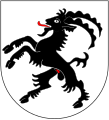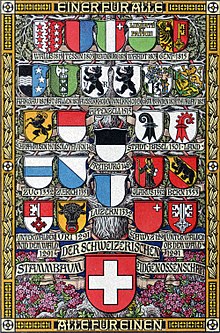Flag and coat of arms of the canton of Graubünden
The coat of arms of the canton of Graubünden combines elements from the coats of arms of the old three leagues . It depicts a capricorn at the bottom and split and quartered shapes at the top. The coat of arms was established by the Small Council on November 8, 1932 and officially recognized by the Federal Council in February 1933.
The blazon of the coat of arms reads: "Split, split at the top: in the 1st split by black and silver; in the 2nd quartered by blue and gold, covered with a crossed cross in confused colors ; in the 3rd in silver upright black ibex ."
The canton's colors were set by the Grand Council on May 5, 1803 in the order gray-white-blue, whereby in practice the color gray is often replaced by black. When defining the colors, one color was adopted from the coats of arms of the three groups: gray stands for the gray union, white for the church union and blue for the ten-court union.
history
From the foundation of the Free State of the Three Leagues to 1803
Until 1799 there was no common coat of arms for the Free State of the Three Leagues. Each of the three groups used its own coat of arms, with the three coats of arms displayed next to one another in the historical order of the groups on facades and on coins. On the left the Upper or Gray Bund, in the middle the Church of God and on the right the Ten Court Bund.
Towards the end of the 15th and the beginning of the 16th century, the Upper or Gray League had two coats of arms side by side. One coat of arms showed a four-sided cross. The base of the coat of arms was sometimes red at first and the cross white, later the red field color disappeared and gave way to a four-part division of gray or black and white with a cross in alternating colors. The other coat of arms showed a shield split by gray and white with Saint George as a shield holder. This second variant has been used in the federal seal since 1505. The other variant was still used for facade paintings and the overall representation of the federal coat of arms until the 18th century.
The black ibex on a silver background as the emblem of the church association and heraldic animal of the bishops of Chur was depicted in the Chur cathedral as early as 1252 . It was later taken over by the League of Episcopal Courts. Mary served as a shield holder in the depiction of Our Lady.
The oldest coat of arms of the Ten Courts Federation showed a simple silver cross in blue, although there was also a variant of a blue cross in gold and vice versa. The "wild man" acted as a shield holder, holding a crossed flag in his right hand and an uprooted fir tree in his left. Older versions sometimes show a simple (not quartered) cross or just the cross. In the seal of 1643 the Bund used a crossed cross in alternating colors in a shield crossed in blue and yellow. In addition to these coat of arms forms, there were two other forms that were only used when the three federal coats of arms were depicted side by side: The wild man, holding a fir tree, alone or the wild man, holding a fir tree, in a split shield, with the right half there is a blue cross on a gold background.
The three coats of arms were first shown united in one shield in 1548 on the medal by Jakob Stampfer in 1548, with the split coat of arms of the Gray League in the upper left, the Capricorn of the Church of God in the upper right and the simple cross of the Ten Court in the lower field. This design did not find widespread use, so that it remained in the seals of the frets until 1799 with the juxtaposition of the shields.
From 1803 to the present
From the founding of the canton in 1803 to 1932, the coats of arms of the three leagues continued to be presented side by side. On April 26, 1803, the Grand Council approved a new drawing of the canton's coat of arms on the occasion of Graubünden's accession as a canton to the Swiss Confederation. The three coats of arms were arranged side by side within a shield, with the shield of the Church of Gods in the middle and in the foreground, almost half of the other coats of arms covering, on the right the coat of arms of the gray, on the left that of the Ten Court. The composition was held within the shield on the left of St. George and on the right of the Wild Man. Maria as the holder of the shield of the Church of God was omitted. In addition, there was also the variant with the shield of the church association as an oval in the middle, to which the other two coats of arms were attached with shield holders and were only slightly covered.
This heraldically incorrect and difficult to implement coat of arms remained in place until the Graubünden government received a request in 1895 to contribute a coat of arms for the armory of the Swiss National Museum in Zurich . The art historian Dr. Josef Zemp chose the form of Stampfer from 1548 for the representation, whereby the current arrangement of the federal coat of arms was used. The disk was executed in 1896 and sparked a new discussion about the canton's coat of arms. In 1911, however, the Cantonal Council rejected an official replacement of the coat of arms. The new coat of arms was used again and again from then on, even in a brochure from the Federal Chancellery on the cantonal coats of arms from 1931. It was not until May 24, 1932 that the Grand Council used the new coat of arms as the official Graubünden coat of arms, whereby the three original shield holders St. Georg, Mary and the Wild Man were recognized. Compared to the design by Zemp from 1896, the colors of the coat of arms of the Gray Confederation were swapped, so that the black color was in the right field of the split shield. The official description of the coat of arms was determined by a resolution of the Graubünden government on November 8, 1932.
The coat of arms can also be found on locomotives of the Rhaetian Railway .
literature
- Registry office of Graubünden: Register of Arms of the Canton of Graubünden , Chur, 1982
- Louis Mühlemann: coat of arms and flags of Switzerland . 3rd edition, Bühler-Verlag, Lengnau 1991, ISBN 3-9520071-1-0
- Pietro von Salis: coat of arms, flag and flag of Graubünden as they must be by law ; Private print Zurich 1936
Web links
Remarks
- ^ Louis Mühlemann: Coats of arms and flags of Switzerland. Zurich 1977, p. 117.










